|

|
Anyone who has been closely following the geopolitical
situation over the last decade would not be in the least surprised
or baffled at why most of the information is now being withheld from
the public.
Objects in the heavens will be playing a
greater and greater role in events down here on the Big
Blue Marble over the next few years, if our hypotheses
is close to correct.
The masters of our world want more "hype and fear of the unknown".
World events are orchestrated for just that effect.
from
SOTT Website |
Jupiter - Our Cosmic Protector?
by Dennis Overbye
July 25, 2009
from
TheNewYorkTimes Website
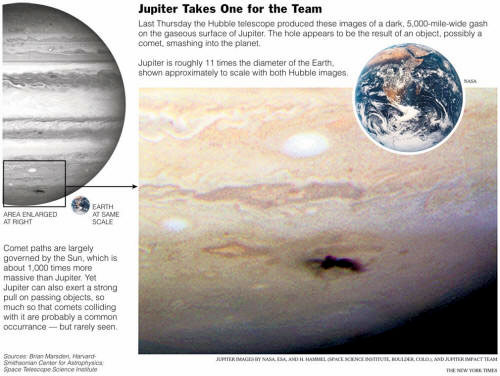
Jupiter Takes One for
the Team
An object, probably a comet that nobody
saw coming, plowed into the giant planetís colorful cloud tops
sometime Sunday, splashing up debris and leaving a black eye the
size of the Pacific Ocean.
This was the second time in 15 years that
this had happened. The whole world was watching when
Comet
Shoemaker-Levy 9 fell apart and its pieces crashed into Jupiter in
1994, leaving Earth-size marks that persisted up to a year.
Thatís Jupiter doing its cosmic job, astronomers like to say. Better
it than us.
Part of what makes the Earth such a nice place to live,
the story goes, is that Jupiterís overbearing gravity acts as a
gravitational shield deflecting incoming space junk, mainly comets,
away from the inner solar system where it could do for us what an
asteroid apparently did for the dinosaurs 65 million years ago.
Indeed, astronomers look for similar configurations
- a giant outer
planet with room for smaller planets in closer to the home stars - in other planetary systems as an indication of their hospitableness
to life.
Anthony Wesley, the Australian amateur astronomer who first noticed
the mark on Jupiter and sounded the alarm on Sunday, paid homage to
that notion when he told The Sydney Morning Herald,
"If anything like that had hit the
Earth it would have been curtains for us, so we can feel very
happy that Jupiter is doing its vacuum-cleaner job and hovering
up all these large pieces before they come for us."
But is this warm and fuzzy image of the
King of Planets as
father-protector really true?
"I really question this idea," said
Brian G. Marsden of the Harvard-Smithsonian Center for
Astrophysics, referring to Jupiter as our guardian planet.
As the former director of the
International Astronomical Unionís Central Bureau for Astronomical
Telegrams, he has spent his career keeping track of wayward objects,
particularly comets, in the solar system.
Jupiter is just as much a menace as a savior, he said. The big
planet throws a lot of comets out of the solar system, but it also
throws them in.
Take, for example,
Comet Lexell, named after the Swedish astronomer
Anders Lexell. In 1770 it whizzed only a million miles from the
Earth, missing us by a cosmic whisker, Dr. Marsden said. That comet
had come streaking in from the outer solar system three years
earlier and passed close to Jupiter, which diverted it into a new
orbit and straight toward Earth.
The comet made two passes around the Sun and in 1779 again passed
very close to Jupiter, which then threw it back out of the solar
system.
"It was as if Jupiter aimed at us
and missed," said Dr. Marsden, who complained that the comet
would never have come anywhere near the Earth if Jupiter hadnít
thrown it at us in the first place.
Hal Levison, an astronomer at the
Southwest Research Institute, in Boulder, Colo., who studies the
evolution of the solar system, said that whether Jupiter was menace
or protector depended on where the comets came from.
Lexell, like
Shoemaker Levy 9 and
probably the truck that just hit Jupiter, most likely came from an
icy zone of debris known as
the Kuiper Belt, which lies just outside
the orbit of Neptune, he explained. Jupiter probably does increase
our exposure to those comets, he said.
But Jupiter helps protect us, he said, from an even more dangerous
band of comets coming from the so-called
Oort Cloud, a vast
spherical deep-freeze surrounding the solar system as far as a
light-year from the Sun.
Every once in a while, in response to
gravitational nudges from a passing star or gas cloud, a comet is
unleashed from storage and comes crashing inward.
Jupiterís benign influence here comes in two forms. The cloud was
initially populated in the early days of the solar system by the
gravity of Uranus and Neptune sweeping up debris and flinging it
outward, but Jupiter and Saturn are so strong, Dr. Levison said,
that, first of all, they threw a lot of the junk out of the solar
system altogether, lessening the size of this cosmic arsenal.
Second, Jupiter deflects some of the
comets that get dislodged and fall back in, Dr. Levison said.
"Itís a double anti-whammy," he
said.
Asteroids pose the greatest danger of
all to Earth, however, astronomers say, and here Jupiterís influence
is hardly assuring.
Mostly asteroids live peacefully in the asteroid
belt between Mars and Jupiter, whose gravity, so the standard story
goes, keeps them too stirred to coalesce into a planet but can cause
them to collide and rebound in the direction of Earth.
Thatís what happened, Greg Laughlin of the University of California
at Santa Cruz, said, to a chunk of iron and nickel about 50 yards
across roughly 10 million to 100 million years ago.
The result is a
hole in the desert almost a mile wide and 500 feet deep in northern
Arizona, called
Barringer Crater.
A gift, perhaps, from our friend
and lord, Jupiter.
Comment
from
Sott Website
Regarding the claim that Jupiter
"protects us from an even more dangerous band of comets coming
from the so-called Oort Cloud", let's see what Clube and Napier,
British astronomers and writers of The Cosmic Serpent, have to
say:
The giant comets normally reside far beyond the planets, in a
spherical cloud surrounding the Sun, called the Oort cloud.
There is also evidence for a flattened disk of comets closer to
the inner solar system, called the Edgeworth/Kuiper belt. What
prompts members of either of these comet repositories to enter
the realm of the planets? Clube and Napier suggest a galactic
influence.
The solar system periodically passes
through the plane of the galaxy as the Sun (and the solar system
with it) orbits the galactic center.
Each passage may dislodge
giant comets and divert them closer to the Sun. The outer
planets, particularly Jupiter, may then perturb some of these
giant comets into orbits which enter the inner solar system.
These comets, stressed both by
gravity and by heat from the sun, may fragment into a cloud of
smaller objects with dynamically similar orbits.
Chiron offers a good example of a giant comet as called for by
Clube and Napier's giant comet hypothesis. Chiron is somewhere
between 148 and 208 kilometers in diameter.
Currently Chiron's
unstable "parking orbit" lies mostly between Saturn and Uranus.
Chiron may end up injected into the inner solar system within a
hundred thousand years, or ejected from the solar system on a
similar time scale.
It is also possible that Chiron has already
visited the inner solar system.
The Taurid complex and the Kreutz sungrazer group are two
families of objects which most likely represent the fragmented
remains of two giant comets in the current era.
SOHO has
recently discovered many new members of the Kreutz group which
were previously unknown.
The Kreutz progenitor was injected into a retrograde orbit and
attained the sungrazing state at a high inclination to the
ecliptic. Hence the debris of its "children" does not pose a
threat to the Earth. The Taurid progenitor on the other hand
ended up in a short-period low-inclination prograde orbit.
This
is why the Earth can encounter its debris with potentially
calamitous results.
What would happen should the Earth pass through the orbit of a
disintegrating giant comet just before or after the comet passes
that same point? Since larger fragments tend to cluster close to
the nucleus of the comet, chances would increase that the Earth
would be bombarded by these larger fragments.
The severity of this comet fragment
shower would far exceed any ordinary meteor shower.
Not only
would "shooting stars" and bright fireballs caused by small
debris appear, but so too would large airbursts and possibly
ground impacts.
These would result in significant destruction
should they occur over an inhabited area.
If a large enough
fragment struck in the ocean - say, 200 meters or so in
diameter - it would raise tsunamis even at a great distance
that would sweep away coastal habitations.
Duncan Steel, a colleague of Clube and Napier, refers to this
process as coherent catastrophism.
Widespread destruction
derives from the coherent arrival of many impactors within a few
days, as opposed to the sporadic arrival of objects spread
randomly in space.
The shower repeats for a period of years
until the cometary orbit precesses so that the Earth no longer
encounters the dense part of the debris field.
(Of course, sporadic debris
unrelated to the disintegrating comet may impact at any time as
well.)
New Image of Jupiter Impact in Infrared
by Nancy Atkinson
July 23, 2009
from
UniverseToday Website
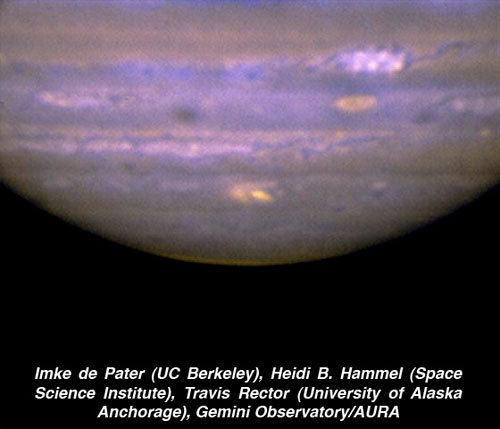
This mid-infrared composite image was obtained
with the Gemini North
telescope on Mauna Kea, Hawai'i,
on 22 July at ~13:30 UT with the
MICHELLE mid-infrared spectrograph/imager.
The impact site is the
bright yellow spot
at the center bottom of Jupiter's disk.
After getting whacked unexpectedly by a small comet or asteroid,
Jupiter is sporting a "bruise," which has been big news this week.
In visible wavelengths, the impact site appears as a black spot.
But
in a new image taken in near infrared by the Gemini North telescope
on Mauna Kea, Hawai'i, the spot shows up in spectacular glowing
yellow.
"We utilized the powerful mid-infrared capabilities of the Gemini
telescope to record the impact's effect on Jupiter's upper
atmosphere," said Imke de Pater from the University of California,
Berkeley.
"At these wavelengths we receive thermal radiation (heat)
from the planet's upper atmosphere. The impact site is clearly much
warmer than its surroundings, as shown by our image taken at an
infrared wavelength of 18 microns."
As Universe Today reported earlier, this new spot on Jupiter was
first seen by Australian amateur astronomer Anthony Wesley on July
19th.
This set off a flurry of activity as the large ground based
observatories have imaged Jupiter in attempt to learn more about the
impact and the object that struck Jupiter.
Astronomers now say the
object was likely a small comet or asteroid, just a few hundreds of
meters in diameter. Such small bodies are nearly impossible to
detect near or beyond Jupiter unless they reveal cometary activity,
or, as in this case, make their presence known by impacting a giant
planet.
In infrared, the impact site shows up in remarkable detail.
"The
structure of the impact site is eerily reminiscent of the larger
Shoemaker-Levy 9 sites 15 years ago," remarked Heidi Hammel
(Space
Science Institute), who was part of the team that supported the
effort at Gemini.
In 1994, Hammel led the Hubble Space Telescope
team that imaged Jupiter when it was pummeled by a shattered comet.
"The morphology is suggestive of an arc-like structure in the
feature's debris field," Hammel noted.
The Gemini images were obtained with the MICHELLE
spectrograph/imager, yielding a series of images at 7 different
mid-infrared wavelengths.
Two of the images (8.7 and 9.7 microns)
were combined into a color composite image by Travis Rector at the
University of Alaska, Anchorage to create the final false-color
image.
By using the full set of Gemini images taken over a range of
wavelengths from 8 to 18 microns, the team will be able to
disentangle the effects of temperature, ammonia abundance, and upper
atmospheric aerosol content.
Comparing these Gemini observations
with past and future images will permit the team to study the
evolution of features as Jupiter's strong winds disperse them.
"The Gemini support staff made a heroic effort to get these data,"
said de Pater.
"We were on the telescope observing within 24 hours
of contacting the observatory." Because of the transient nature of
this event, the telescope was scheduled as a "Target of Opportunity"
and required staff to react quickly to the request."
Backyard Astronomer spots Big Bang on
Jupiter
by Asher Moses
July 21, 2009
from
SMH Website
An amateur Australian astronomer has set the space-watching world on
fire after discovering that a rare comet or asteroid had crashed
into Jupiter, leaving an impact the size of Earth.
Anthony Wesley, 44, a computer programmer from Murrumbateman, a
village north of Canberra, made the discovery about 1am yesterday
using his backyard 14.5-inch reflecting telescope.
The impact would have occurred no more than two days earlier and
will only be visible for another few days.
Within hours, his images had spread across the internet on science
websites.
NASA's Jet Propulsion Laboratory confirmed the discovery at 9pm
yesterday using its large infrared telescope at the summit of Mauna
Kea in Hawaii.
The only other time astronomers have discovered evidence of a space
object having hit Jupiter was when the
Shoemaker-Levy 9 comet
collided with the giant planet in July, 1994.
That event was also the first direct observation of two objects
colliding in space.
Glenn Orton, the NASA scientist who confirmed Wesley's discovery,
said:
"We are extremely lucky to be seeing Jupiter at exactly the
right time, the right hour, the right side of Jupiter to witness the
event. We couldn't have planned it better."
Orton said he was not yet sure whether the object that hit Jupiter
was a comet, asteroid or some other piece of space junk.
But the
impact mark is about the size of the Earth.
"It's been a whirlwind of a day and this, on the anniversary of the
Shoemaker-Levy 9 and Apollo anniversaries, is amazing," he said.
To most people the image is unremarkable and appears as little more
than a scar on Jupiter's vast gas surface.
Leigh Fletcher, an astronomer who worked with Orton on confirming
the discovery last night, said:
"These are the most exciting
observations I've seen in my five years of observing the outer
planets."
Wesley said in a phone interview that documenting these sorts of
impacts was the only way to get new data on how the solar system
formed and what planets such as Jupiter are made of, as the impact
throws up debris that would otherwise be invisible when looking
through a telescope from Earth.
The collision also allows astronomers to examine Jupiter's role in
cleaning up space debris in the solar system.
"If anything like that had hit the Earth it would have been curtains
for us, so we can feel very happy that Jupiter is doing its
vacuum-cleaner job and hovering up all these large pieces before
they come for us," he said.
"An impact event like this, even just knowing how often they happen,
gives you some idea of how much debris is left over from the solar
system when it formed and how quickly Jupiter is vacuuming up the
remains of the bits and pieces floating around in the solar system."
Mike Salway, who runs the Australian amateur astronomy community
website
iceinspace.com.au, said astronomers around the world were
raving about the discovery.
"Amateur astronomers are all over it at the moment - they all had
their telescopes out last night looking for it," he said.
Wesley, who has been keen on astronomy since he was a child, said
telescopes and other astronomy equipment were so inexpensive now
that the hobby had become a viable pastime for just about anybody.
His own equipment cost about $10,000.
In many cases, particularly with planets such as Jupiter,
professional space watchers were turning to amateurs to provide them
with new discoveries.
"A lot of the professional astronomers have access to large scopes
but those scopes are in demand for all sorts of other jobs and you
just can't afford to tie up a large telescope worth millions of
dollars looking at Jupiter every night," Wesley said.
"These large telescopes only get built because of the interests of
the consortium parties, and those interests need to be attended to,
so it's really left to amateurs who've got no fixed agenda to image
whatever they find interesting."
A new Bright Spot on Venus
by Dr. Emily Baldwin
ASTRONOMY NOW
July 21, 2009
from
AstronomyNow Website
An intense bright spot has appeared in the clouds of Venus. Could it
be associated with volcanic activity on the surface?
The Solar System is breaking out in spots. First Jupiter took a
smack from a passing asteroid or comet, manifesting as a dark scar
in the Jovian atmosphere, and now Venus is sporting a brilliant
white spot in its southern polar region.
In an alert to fellow amateur astronomers, Venus observer Frank Melillo reports on his images captured on 19 July:
"I have seen
bright spots before but this one is an exceptional bright and quite
intense area."
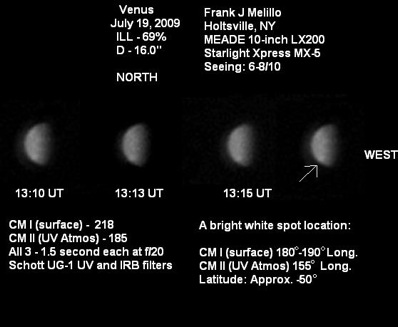
Venus' bright spot as captured by
Frank Melillo from New York.
Image
courtesy Frank Melillo.
He suggests that it could be explained as an atmospheric effect,
but
could it be a sign of volcanic activity at the planet's surface?
Venus is covered in a thick cloak of clouds which prevents any
visible observation of the surface.
Instead, radar is used to map
the surface, but volcanic activity has never been observed directly.
"A volcanic eruption would be nice, but let's wait and find out!"
says Venus specialist Dr Sanjay Limaye of the University of
Wisconsin.
"An eruption would have to be quite energetic to get a
cloud this high."
Furthermore, at a latitude of 50 degrees south,
the spot lies outside the region of known volcanoes on Venus.
Melillo comments that the spot will not be seen again as intense as
it is now, thanks to the rapid rotation of the planet's atmosphere.
"I hope that someone will image Venus on Thursday when this part of
the atmosphere is facing us again," he says.
Further observations will help shed light on the genesis of the
bright spot and how it evolves as the atmosphere churns over.
Jupiter Collision a Warning Call to Earth
by Peter N. Spotts
Staff writer of The Christian Science
Monitor
July 21, 2009
from
ChristianScienceMonitor Website
The list of cosmic objects that could hit Earth is growing.
Scientists study satellite 'tractors' and nuclear weapons as ways to
divert asteroids headed our way.
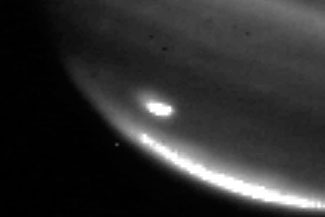
This detail image
shows a large impact
shown on the bottom
left on Jupiter's south polar region captured on July 20,
by NASA's Infrared
Telescope Facility in Mauna Kea, Hawaii.
Infrared Telescope Facility/Handout/JPL/NASA/Reuters
When an object smacked into Jupiter over the weekend, giving
astronomers their best cosmic-collision show since the comet
Shoemaker-Levy 9 in 1994, the giant gas ball of a planet took the
poke like the Pillsbury Dough Boy.
For all its scientific interest, however, the collision also serves
as a stark reminder that the solar system remains a shooting gallery
Ė with Earth, as well as Jupiter, on the wrong side of the firing
line.
The object's signature on Jupiter's cloud tops initially was
discovered by Australian amateur astronomer Anthony Wesley as he
gathered digital images of the giant planet through his 14.5-inch
telescope.
After alerting other astronomers to what appeared to be a
"scar" in the cloud tops similar to those generated by the pieces of
Shoemaker-Levy 9, NASA scientists trained a 3-meter (9.8-foot)
infrared telescope on the planet and got a good look at the scar.
"It could be the impact of a comet," according to Glenn Orton, a
scientist at NASA's Jet Propulsion Laboratory (JPL) in Pasadena,
Calif., in a statement yesterday.
"But we don't know for sure yet."
When it comes to objects Earthlings should keep an eye on, the
catalog scientists have amassed is swelling.
Since 1995, astronomers associated with 10 search projects have
discovered more than 6,200 near-Earth asteroids of all sizes,
according to data from JPL. Some 784 are at least a kilometer (0.62
miles) across or larger.
Just over 1,000 of the total have been
deemed "potentially hazardous" Ė those that pass Earth at a distance
of less than 4.7 million miles.
And while the biggest ones have the potential to inflict the most
damage, scientists are gaining a new appreciation of the punch even
small ones can deliver.
Two and a half years ago, scientists at Sandia National Laboratories
in Albuquerque, N.M., conducted advanced supercomputer simulations
of the
June 1908 event over Siberia that flattened and scorched
trees over a region 30 miles across.
Estimates put the explosive
clout of the air burst from either a meteor or comet fragment at
between 10 and 20 megatons.
-
The good news: Calculations on Sandia's supercomputer, in 3-D, push
that explosive yield down to between three and five megatons.
-
The
bad news: The calculations also indicated that the asteroid or comet
fragment was much smaller than previously estimated.
There are more
small asteroids hurtling around us than large ones.
Sometimes they can seem to come out of nowhere.
Last October, astronomers detected an asteroid an estimated two to
five meters across. Some 21 hours later, it entered the atmosphere
over northern Sudan sprinkling the Nubian desert with meteorites.
The object's blast was estimated at roughly 1,000 tons of TNT.
For asteroid specialists, this was a live-fire test of protocols
they'd developed to alert astronomers to monitor the object to
refine orbital and impact-location estimates Ė and to alert national
authorities that a direct hit was on the way.
The incident "underscored the successful evolution of the Near-Earth
Object Program's discovery and orbit-prediction process," wrote JPL
scientists Steve Chesley, Paul Chodas, and Don Yeomans in a
post-event report on the incident.
The goal, of course, is to spot these objects and produce highly
refined orbit estimates in time to take defensive action, if
necessary.
And what might that action look like?
In a lengthy analysis of options that earned him a newly-minted PhD
in aeronautical engineering from the University of Glasgow, Joan Pau
Sanchez Cuartielles sorts through several approaches ranging from
detonating a small nuclear bomb near an asteroid to using a
modest-sized satellite as a kind of tractor that tugs the asteroid
into a less dangerous orbit, connected to the asteroid by their
mutual gravity.
The stand-off nuclear option (with an explosive yield tailored to
the mass and density of the asteroid) turned out to be the most
effective, although politically troublesome.
The gravity tug could
be effective with long lead times, or if the goal is to nudge an
asteroid just enough to ensure it avoids a gravitational sweet spot,
or keyhole, that would put it on a collision course with Earth
decades into the future.
Jupiter sports new 'bruise' from impact
by Lisa Grossman
21 July 2009
from
NewScientist Website
Something has smashed into Jupiter, leaving behind a black spot in
the planet's atmosphere, scientists confirmed on Monday.
|
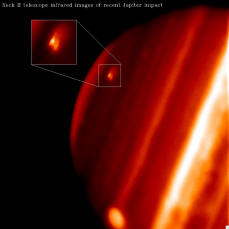 |
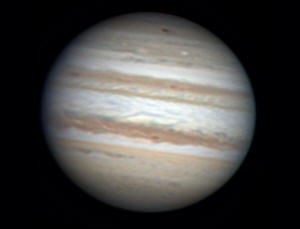 |
|
Infrared observations
taken at the Keck II telescope in Hawaii
reveal a bright spot
where the impact occurred.
The spot looks black
at visible wavelengths
(Image: Paul Kalas/Michael
Fitzgerald/Franck Marchis/LLNL/UCLA/UC Berkeley/SETI Institute)
|
Amateur
astronomer Anthony Wesley snapped this image of the new
black spot (near the top of Jupiter's disc) on Sunday,
just after discovering it
(Image:
Anthony Wesley)
|
This is only the second time such an impact has been observed.
The
first was almost exactly 15 years ago, when more than 20 fragments
of comet Shoemaker-Levy 9 collided with the gas giant.
"This has all the hallmarks of an impact event, very similar to
Shoemaker-Levy 9," said Leigh Fletcher, an astronomer at NASA's Jet
Propulsion Lab in Pasadena, California.
"We're all extremely
excited."
The impact was discovered by amateur astronomer Anthony Wesley in
Murrumbateman, Australia at about 1330 GMT on Sunday.
Wesley noticed
a black spot in Jupiter's south polar region (see above image) Ė but he
very nearly stopped observing before he saw it.
"By 1am I was ready to quit... then changed my mind and decided to
carry on for another half hour or so," he wrote in his observation
report.
Initially he suspected he was seeing one of Jupiter's moons
or a moon's shadow on the planet, but the location, size and speed
of the spot ruled out that possibility.
'Stroke of luck'
After checking images taken two nights earlier and not seeing the
spot, he realized he had found something new and began emailing
others.
Among the people he contacted were Fletcher and Glenn Orton, also at
JPL.
They had serendipitously scheduled observing time on NASA's
InfraRed Telescope Facility in Hawaii for that night.
"It was a fantastic stroke of luck," Orton told
New Scientist.
Their team began observations at about 1000 GMT on 20 July, and
after six hours of observing confirmed that the spot was an impact
and not a weather event.
"It's completely unlike any of the weather phenomena that we observe
on Jupiter," Orton says.
Splash
The first clue was a near-infrared image of the upper atmosphere
above the impact site.
An impact would make a splash like a stone
thrown into a pool, scattering material in the atmosphere upwards.
This material would then reflect sunlight, appearing as a bright
spot at near-infrared wavelengths.
And that's exactly what the team saw.
"Our first image showed a
really bright object right where that black scar was, and
immediately we knew this was an impact," Orton says.
"There's no
natural phenomenon that creates a black spot and bright particles
like that."
Supporting evidence came from measurements of Jupiter's temperature.
Thermal images also showed a bright spot where the impact took
place, meaning the impact warmed up the lower atmosphere in that
area.
The researchers have also found hints of higher-than-normal amounts
of ammonia in the upper atmosphere. Extra ammonia had been churned
up by the previous Shoemaker-Levy comet impact.
Exotic chemistry
The Shoemaker-Levy impact also introduced some exotic chemistry into
Jupiter's atmosphere. The energy from the collision fused some of
the original atmospheric components into new molecules, such as
hydrogen cyanide.
Scientists hope this new impact has done the same thing, since that
would allow them to follow the new materials and learn how the
atmosphere moves with time.
So what was the impactor?
"Not a clue," Orton says.
He speculates
that it could have been a block of ice from somewhere in Jupiter's
neighborhood, or a wandering comet that was too faint for
astronomers to detect before the impact.
"We don't know if the impact was produced by a comet or an
asteroid," agrees Franck Marchis, an astronomer at the University of
California, Berkeley, and the SETI Institute, who was part of a team
that observed the spot on Sunday with the Keck Observatory in Hawaii.
If the object was large enough to be visible before
impact, current surveys of asteroids may not have been looking in
the right direction to find it, he says, adding that future surveys
will spot more of the solar system's uncatalogued objects.
Asteroid or comet
Spectra collected by various observatories may help identify what
the impactor was, since a large amount of water at the impact
location would hint at a comet as the source.
"We will also compare
the observations with those collected during [Shoemaker-Levy 9] 15
years ago," since that was a known comet, Marchis says.
Without having seen it, scientists can't tell how large the object
was.
"But the impact scar we're seeing is about the same size as one
of Jupiter's big storms, Oval BA, Fletcher told New Scientist.
"That, I believe, is about the size of the Earth."
Marchis says Jupiter may be protecting Earth from getting hit by
such objects.
"The solar system would have been a very dangerous
place if we did not have Jupiter," he told New Scientist.
"We should
thank our Giant Planet for suffering for us. Its strong
gravitational field is acting like a shield protecting us from
comets coming from the outer part of the solar system."
Stephen Hawking - "Asteroid Impacts
Biggest Threat to Intelligent Life in the Galaxy"
by Casey Kazan with Rebecca
Sato
June 26, 2009
from
DailyGalaxy Website
Asteroids, Stephen Hawking believes, that one of the major
factors in the possible scarcity of intelligent life in our galaxy
is the high probability of an asteroid or comet colliding with
inhabited planets.
We have observed, Hawking points out in
Life in the Universe, the collision of a comet,
Shoemaker-Levy 9, with Jupiter
(below), which produced a series of enormous fireballs, plumes many
thousands of kilometers high, hot "bubbles" of gas in the
atmosphere, and large dark "scars" on the atmosphere which had
lifetimes on the order of weeks.
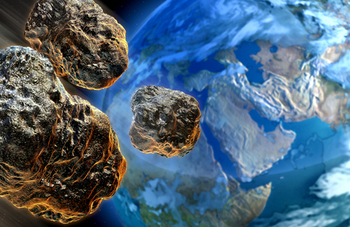
It is thought the collision of a rather
smaller body with the Earth, about 70 million years ago, was
responsible for the extinction of the dinosaurs.
A few small early
mammals survived, but anything as large as a human, would have
almost certainly been wiped out.
Through Earth's history such collisions occur, on the average every
one million year. If this figure is correct, it would mean that
intelligent life on Earth has developed only because of the lucky
chance that there have been no major collisions in the last 70
million years.
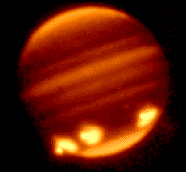 Other
planets in the galaxy, Hawking believes, on which life has
developed, may not have had a long enough collision free period to
evolve intelligent beings. Other
planets in the galaxy, Hawking believes, on which life has
developed, may not have had a long enough collision free period to
evolve intelligent beings.
"The threat of the Earth being hit
by an asteroid is increasingly being accepted as the single
greatest natural disaster hazard faced by humanity," according
to Nick Bailey of the University of Southampton's School of
Engineering Sciences team, who has developed a threat
identifying program.
[Image right - Comet Shoemaker-Levy 9
collision with Jupiter]
The team used raw data from multiple
impact simulations to rank each country based on the number of times
and how severely they would be affected by each impact.
The software, called
NEOimpactor (from NASA's
"NEO" or Near Earth Object program), has been specifically
developed for measuring the impact of 'small' asteroids under one
kilometer in diameter.
Early results indicate that in terms of population lost, China,
Indonesia, India, Japan and the United States face the greatest
overall threat; while the United States, China, Sweden, Canada and
Japan face the most severe economic effects due to the
infrastructure destroyed.
The top ten countries most at risk are:
-
Brazil
-
China
-
Indonesia
-
India
-
Italy
-
Japan
-
Nigeria
-
Philippines
-
United Kingdom
-
United States
"The consequences for human
populations and infrastructure as a result of an impact are
enormous," says Bailey.
"Nearly one hundred years ago a
remote region near the Tunguska River witnessed the largest
asteroid impact event in living memory when a relatively small
object (approximately 50 meters in diameter) exploded in
mid-air.
While it only flattened unpopulated
forest, had it exploded over London it could have devastated
everything within the M25. Our results highlight those countries
that face the greatest risk from this most global of natural
hazards and thus indicate which nations need to be involved in
mitigating the threat."
What would happen to the human species
and life on Earth in general if an asteroid the size of the one that
created the famous
K/T Event of 65 million years ago
at the end of the Mesozoic Era that resulted in the extinction of
the dinosaurs impacted our planet.

As Stephen Hawking says,
the
general consensus is that any comet or asteroid greater than 20
kilometers in diameter that strikes the Earth will result in the
complete annihilation of complex life - animals and higher plants.
(The
asteroid Vesta, for example, one of
the destinations of the
Dawn Mission, is the size of
Arizona).
How many times in our galaxy alone has life finally evolved to the
equivalent of our planets and animals on some far distant planet,
only to be utterly destroyed by an impact? Galactic history suggests
it might be a common occurrence.
The first this to understand about the K/T event is that is was
absolutely enormous: an asteroid (or comet) six to 10 miles in
diameter streaked through the Earth's atmosphere at 25,000 miles an
hour and struck the Yucatan region of Mexico with the force of 100
megatons - the equivalent of one Hiroshima bomb for every person
alive on Earth today. Not a pretty scenario!
Recent calculations show that our planet would go into another
"Snowball Earth" event like the one that occurred 600 million years
ago, when it is believed the oceans froze over (although some
scientists dispute this hypothesis -see link below).
While microbial bacteria might readily survive such calamitous
impacts, our new understanding from the record of the Earth's mass
extinctions clearly shows that plants and animals are very
susceptible to extinction in the wake of an impact.
Impact rates depend on how many comets and asteroids exist in a
particular planetary system. In general there is one major impact
every million years -a mere blink of the eye in geological time.
It also depends on how often those
objects are perturbed from safe orbits that parallel the Earth's
orbit to new, Earth-crossing orbits that might, sooner or later,
result in a catastrophic K/T or Permian-type mass extinction.
The
asteroid that hit Vredefort located
in the Free State Province of South Africa is one of the largest to
ever impact Earth, estimated at over 10 km (6 miles) wide, although
it is believed by many that the original size of the impact
structure could have been 250 km in diameter, or possibly larger
(though the Wilkes Land crater in Antarctica, if confirmed to have
been the result of an impact event, is even larger at 500 kilometers
across).
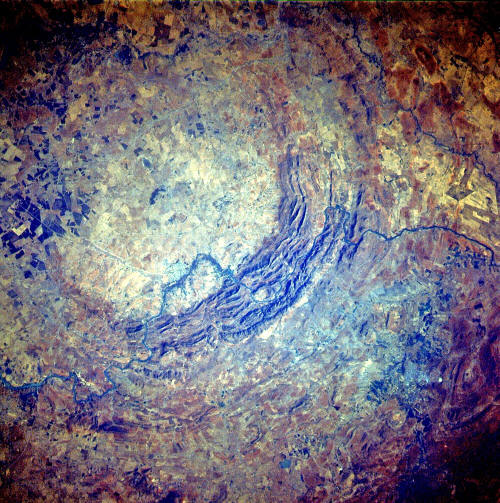
The town of Vredefort is situated in the
crater (image above).
Dating back 2,023 million years, it is the oldest astrobleme
found on earth so far, with a radius of 190km, it is also the most
deeply eroded.
Vredefort Dome Vredefort bears witness to the worldís
greatest known single energy release event, which caused devastating
global change, including, according to many scientists, major
evolutionary changes.
What has kept the Earth "safe" at least the past 65 million years,
other than blind luck is the massive gravitational field of
Jupiter, our cosmic guardian, with its stable circular orbit far
from the sun, which assures a low number of impacts resulting in
mass extinctions by sweeping up and scatters away most of the
dangerous Earth-orbit-crossing comets and asteroids
Jupiter increases risk of comet strike on Earth
by David Shiga
24 August 2007
from
NewScientist Website
Contrary to prevailing wisdom, Jupiter does not protect Earth from
comet strikes. In fact, Earth would suffer fewer impacts without the
influence of Jupiter's gravity, a new study says.
It could have
implications for determining which solar systems are most hospitable
to life.
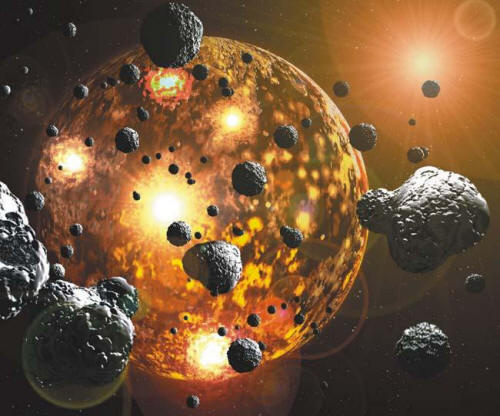
Earth experienced an
especially heavy bombardment
of asteroids and
comets early in the solar system's history
(Illustration: Julian
Baum)
A 1994 study showed that replacing Jupiter with a much smaller
planet like Uranus or Neptune would lead to 1000 times as many
long-period comets hitting Earth.
This led to speculation that
complex life would have a hard time developing in solar systems
without a Jupiter-like planet because of more intense bombardment by
comets.
But a new study by Jonathan Horner and Barrie Jones of
Open
University in Milton Keynes, UK, shows that if there were no planet
at all in Jupiter's orbit, Earth would actually be safer from
impacts.
The contradictory results arise because Jupiter affects comets in
two different, competing ways.
Its gravity helps pull comets into
the inner solar system, where they have a chance of hitting Earth,
but can also clear away Earth-threatening comets by ejecting them
from the solar system altogether, via a gravitational slingshot
effect.
Tripled impacts
According to the new study, the worst scenario for Earth is when
Jupiter is replaced by a planet with about the mass of Saturn.
"[Such a planet] is fairly capable of putting things into an
Earth-crossing orbit, but still has some difficulty ejecting them,
so they will stay on an Earth-crossing orbit for a much longer
time," Horner told New Scientist.
The projected result was more than
three times as many impacts as in the real solar system.
So both the new study and the one from 1994 suggest that a smaller
planet in Jupiter's orbit would leave Earth worse off, although they
disagree about how much worse.
That may be because they differ on the source of the comets they
examine. Horner looked at objects coming from the Kuiper belt, a
region just beyond Neptune's orbit where many dormant comets reside.
The previous study, meanwhile, looked at the Oort cloud, a vast
collection of dormant comets extending hundreds of times further
from the Sun.
Ultimately, knowing what kinds of solar systems are safest from
bombardment could help in the search for alien life.
But, despite
the latest work, it is still unclear where we should be looking.
Asteroid threat
Alessandro Morbidelli of Nice Observatory in France, who studies
solar system dynamics, says neither Horner's analysis nor the earlier
study included the most important source of impacts - the asteroid
belt. About 95% of the impacts on Earth are due to asteroids, he
says.
He suspects that a smaller planet in place of Jupiter may lead to
fewer asteroid impacts.
"Given that near-Earth asteroids dominate
the impact rate, decreasing asteroid impacts might cause a decrease
in the overall bombardment rate of the Earth," he told New
Scientist.
Horner and Jones plan to extend their study to include asteroids,
but Morbidelli says there are even more factors to examine.
"You can
imagine solar systems where a much more massive and broader asteroid
belt is preserved - it would be difficult to live in that solar
system," he says.
"You can imagine giant planets migrating and
destroying an asteroid belt. There are so many factors it is
difficult to handle them all."
The results were presented Friday at the
European Planetary Science
Congress 2007 in Potsdam, Germany.
Video
Something Wicked this way comes
by
thesignsteam
October 30, 2007
from
YouTube Website
A
short film about
the Oort Cloud which surrounds our solar system and
the growing evidence that we belong to a binary star system.
|









 Other
planets in the galaxy, Hawking believes, on which life has
developed, may not have had a long enough collision free period to
evolve intelligent beings.
Other
planets in the galaxy, Hawking believes, on which life has
developed, may not have had a long enough collision free period to
evolve intelligent beings.

